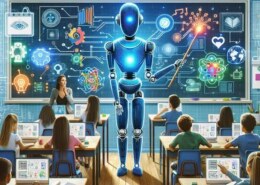Artificial Intelligence (AI) is no longer just a futuristic concept—it’s actively reshaping how we teach and learn. From smart tutoring systems to real-time feedback and personalized lesson plans, AI is revolutionizing education in ways we couldn’t have imagined a decade ago. As classrooms evolve, the question isn’t if AI will play a role, but how we can best use it to support students and teachers alike.
1. Personalized Learning for Every Student
AI excels at analyzing data to create customized learning experiences. By tracking a student’s progress, learning pace, and preferences, AI can recommend targeted exercises, suggest review topics, or even adjust the difficulty level of assignments.
This approach helps:
-
Struggling students receive extra support
-
Advanced learners move ahead without being held back
-
Teachers focus on individual needs rather than a one-size-fits-all model
2. Intelligent Tutoring and Real-Time Support
Platforms like Carnegie Learning or Khanmigo use AI to simulate the experience of a personal tutor. These systems can:
-
Answer questions on demand
-
Offer tailored explanations
-
Guide students through problem-solving in real time
This kind of support is especially valuable for after-school learning or remote education, where teacher availability may be limited.
3. Automating the Administrative Workload
Grading papers, marking attendance, and planning lessons are time-consuming tasks. AI can automate these processes, giving teachers more time to do what they do best—connect with students, foster creativity, and manage the classroom.
4. Immersive and Engaging Learning Environments
AI works hand-in-hand with tools like Virtual Reality (VR), Augmented Reality (AR), and educational games to make lessons more engaging.
Examples include:
-
Virtual field trips to historical landmarks
-
Interactive science labs using simulations
-
Language-learning games that adapt to student skill levels
These technologies help students visualize complex topics and learn by doing, not just memorizing.
5. Inclusive Learning for All
AI tools are breaking barriers in education by supporting diverse learners. Features like:
-
Real-time translation
-
Speech-to-text for students with hearing impairments
-
Predictive text and visual aids for students with learning disabilities
make classrooms more accessible and inclusive than ever before.
6. Early Intervention Through Predictive Analytics
AI can detect patterns that indicate when a student may be falling behind—before it becomes a serious issue. Teachers can then provide timely interventions, such as extra tutoring or family support, to get students back on track.
7. The Challenges: Ethics, Equity, and Data Privacy
As promising as AI is, it’s not without its pitfalls. Schools and developers must consider:
-
Data privacy: How is student data collected, stored, and used?
-
Bias: Are AI algorithms unintentionally reinforcing inequality?
-
Access: Do all schools have equal access to AI-powered tools?
Without careful planning, AI could unintentionally widen existing educational gaps.
8. The Future of Learning Is Human-Centered
Despite its capabilities, AI can’t replace the emotional intelligence, empathy, and intuition of a great teacher. The most effective classrooms will be those where AI enhances—not replaces—human instruction.
Final Thoughts
AI is already transforming education, and its influence will only grow. When used thoughtfully and ethically, AI can be a powerful tool for making learning more personalized, inclusive, and effective. The future of education is not about replacing teachers—it’s about equipping them with the tools to reach every student, every day.

